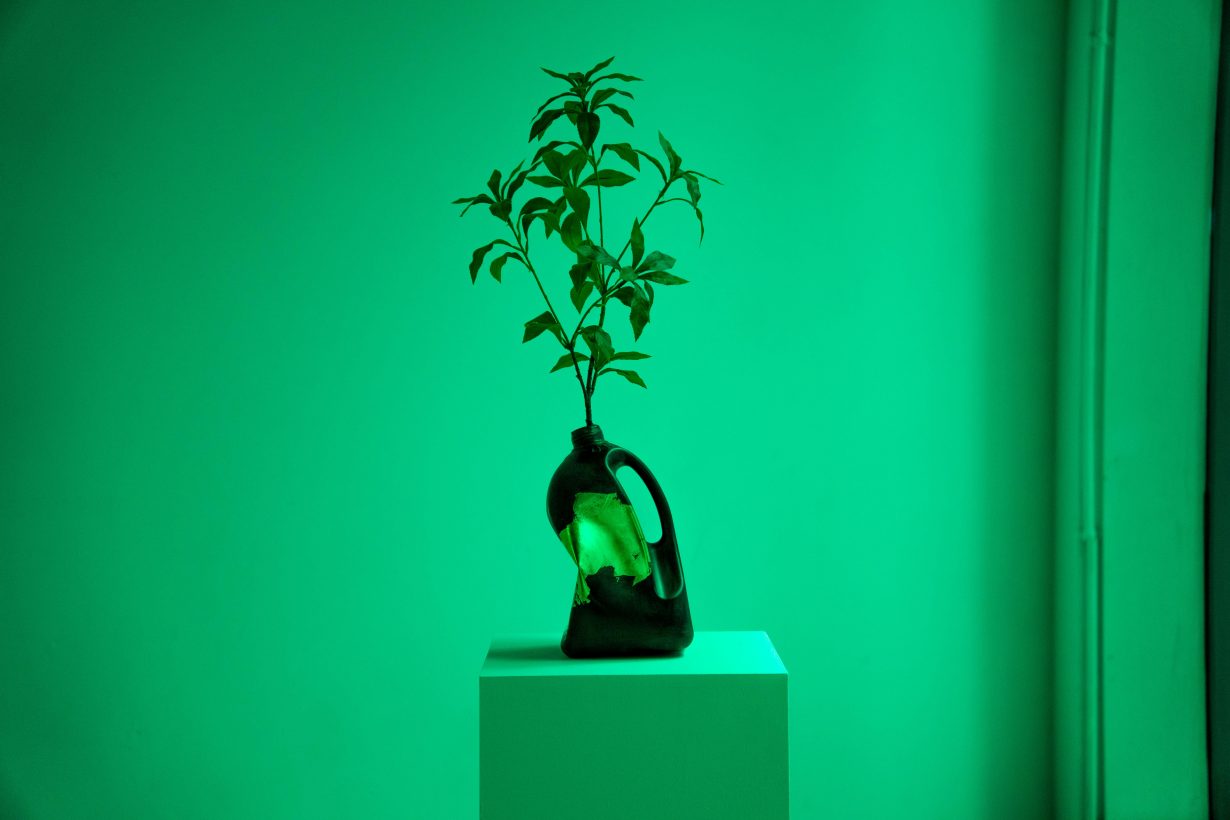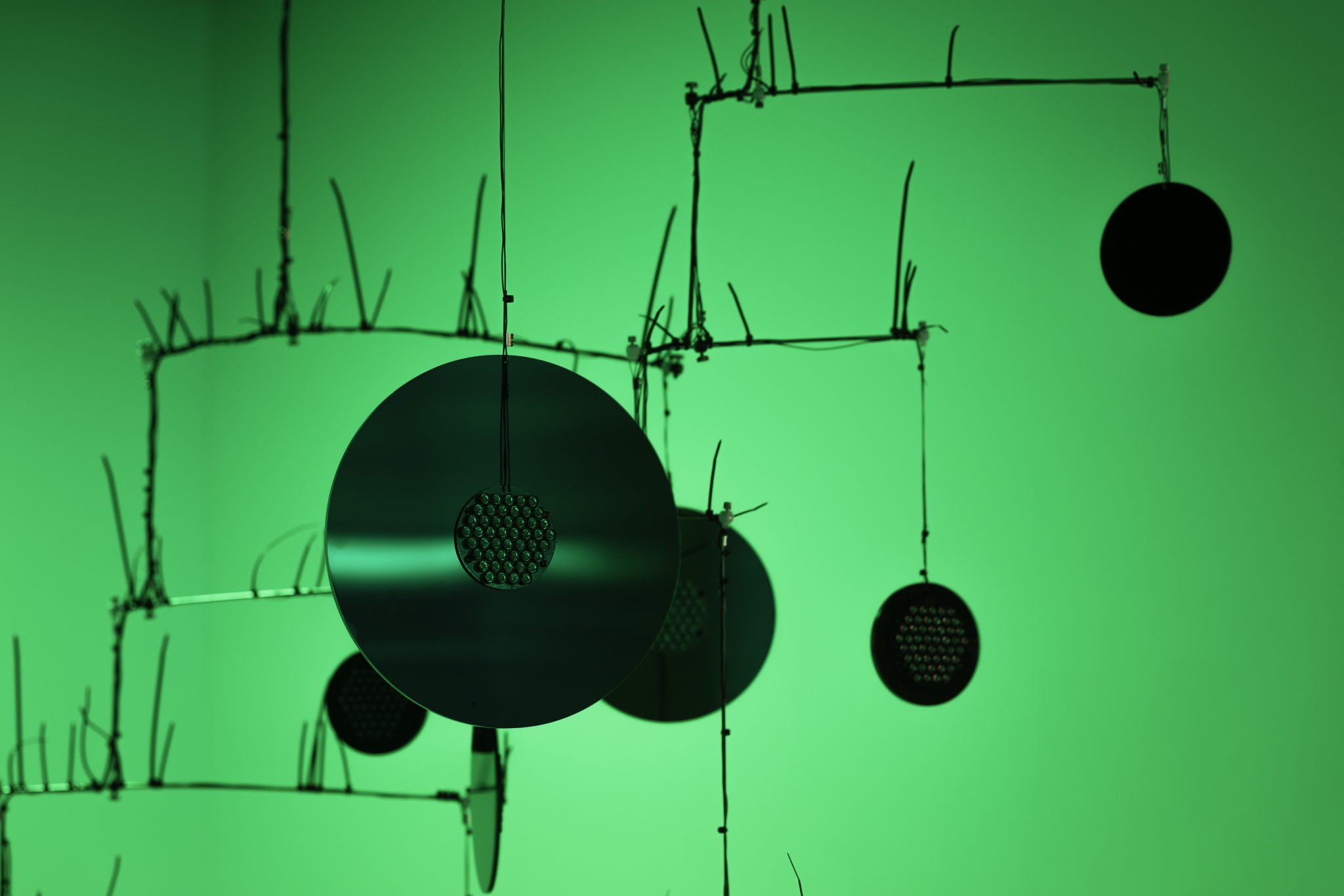Audible Garden at Korean Cultural Centre UK, London radically rearranges the constituent parts of our everyday perceptive experience
Jinjoon Lee’s immersive exhibition, bathed in a neon-green ambient light, deals with perceptions, memory and a certain level of digital synaesthesia. In the abstract mural Audible Garden (all works 2023), which opens Lee’s eponymous show, scattered plot-points, representing (via their sizes) the velocities of each of the 88 MIDI notes from 22 to 109 (y-axis) at each given time (x-axis), form a diagram of sound. Packed in an orderly fashion onto a dotted grid, it recalls foggy mountains and trickling water streams (as you go back and forth in front of the work, the dotted image ‘flows’ as if animated) printed through a halftone process. On the other side of the wall is Daejeon, Summer of 2023, the source of this information graphic. Here, two rows of pale plaster discs cast in the shape of vinyl records are aligned on the wall, each depicting a pattern painted in ink that look like the growth rings of trees or isolines on a topographic map. Nearby, one of these painted discs rotates on a record player, and a camera, functioning like a stylus, reads the greyscale values of the image, converting them into melodies via a predetermined algorithm – one similar to the algorithm that informs the MIDI indexes and velocities in Audible Garden. What the camera captures is then enlarged, applied with a monochrome filter and projected onto the opposite wall – a series of transformations turning the simplistic plaster discs into a mixture of visually and auditorily enhanced experiences.

This long and winding journey of image processing – and metaphorically of our daily reality heavily mediated by technology, as the wall text tells us – characterises Lee’s show. In Lee’s work, every bit of our everyday perceptive experience is radically rearranged, to call attention to the blurry line between natural and artificial sensations. In Hanging Garden, recordings of birds chirping, flowing water and children’s laughter, intermingled with sirens and other urban noises, are broadcast into the gallery through a dozen dangling and slowly rotating directional loudspeakers. As one walks around and through the installation, the source of each sound in the installation becomes increasingly obscure, meshing natural and constructed spaces into the same disorienting soundscape. In Thrown and Discarded Emotions, five torso-height sculptures translate Lee’s brainwave charts into plaster scholar stones – a staple display in the homes of East Asian literati that evokes nature and embodies an elevated interiority – their curving contours resembling at once medical diagrams and digital glitches. If in Daejeon, Summer of 2023, there’s an artificial sense of synaesthesia in the way visual and audio signals are translated and reprogrammed, here the invisible electrical impulses tied to one’s perception and memory are given a physical form – stripped of their medical significance, these dull analogue shapes appear, perhaps intentionally, rather clumsy and odd.
The work that takes us back to our grounded, organic reality is a series of plaster sculptures cast from battered milk bottles scattered through the latter half of the show. In Fresh Nature: Black Milk, the solid black casts look as if the colour of milk had been digitally inverted, giving this quotidian nourishment an odd materiality. Still, they feel familiar. Unlike the artificially generated sound and imagery, the crushed shapes of the milk bottles suggest a knowable past with accidental contacts. Such might be the comfort of our corporeal world, in which a disorderly reality always threatens to escape algorithmic mediation.
Audible Garden at Korean Cultural Centre UK, London, 1 July – 13 October
